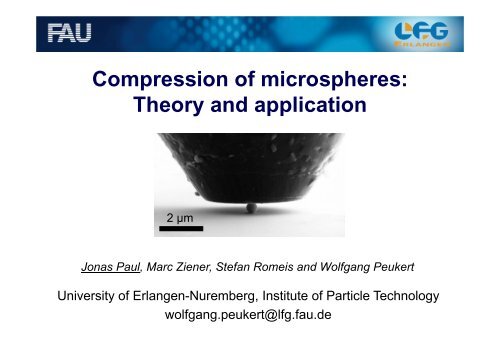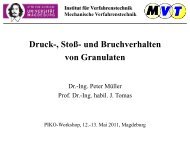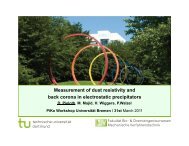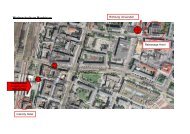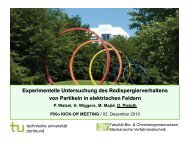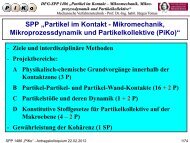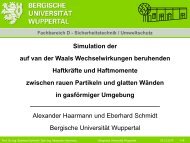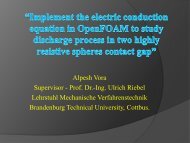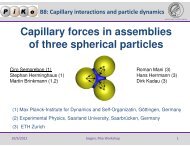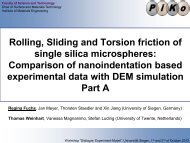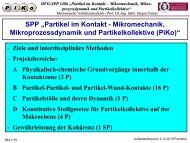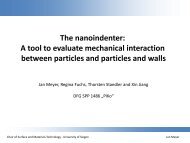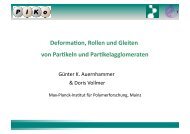Compression of microspheres: Theory and application
Compression of microspheres: Theory and application
Compression of microspheres: Theory and application
Create successful ePaper yourself
Turn your PDF publications into a flip-book with our unique Google optimized e-Paper software.
<strong>Compression</strong> <strong>of</strong> <strong>microspheres</strong>:<br />
<strong>Theory</strong> <strong>and</strong> <strong>application</strong><br />
2 µm<br />
Jonas Paul, Marc Ziener, Stefan Romeis <strong>and</strong> Wolfgang Peukert<br />
University <strong>of</strong> Erlangen-Nuremberg, Institute <strong>of</strong> Particle Technology<br />
wolfgang.peukert@lfg.fau.de
Experimental Setup<br />
Custom built SEM supported micromanipulator :<br />
(J. Paul et al., Rev. Sci. Instruments 2012)<br />
Characteristics:<br />
• Tunable spring constant<br />
• Precise determination <strong>of</strong> spring<br />
constant<br />
• Force resolution < 50nN<br />
• Deformation resolution < 5nm<br />
• Lateral scan field 80µm x 80µm<br />
Technical data:<br />
LVDT<br />
Electronic noise: 250nV pp @10kHz<br />
Sensitivity: 1.8·10 -7 V/nm<br />
Displacement resolution: ∆z = 1,4nm pp @10kHz<br />
J. Paul PiKo-Workshop Siegen 2012<br />
Force resolution: ∆F = ∆z·k > 50nN pp<br />
(35N/m < k < 15000N/m) @10kHz<br />
Strain gauge resolution: 5nm pp @10kHz<br />
Loadingrate: 50 – 5000µN/s<br />
2
Obtained Data<br />
Representative force-deformation plot <strong>of</strong> a silica sphere (x = 500nm):<br />
Information on:<br />
• Young’s modulus<br />
• Elastic range<br />
• Yield strength<br />
• Hardness<br />
• Crack initialization<br />
• Elastic energy<br />
• Dissipated energy<br />
• Elastic-plastic loading index<br />
Force [µN]<br />
1200<br />
1000<br />
800<br />
600<br />
400<br />
200<br />
Relative deformation<br />
0.00 0.18 0.37 0.55 0.73<br />
SiO 2<br />
(x=500nm)<br />
elastic-plastic<br />
loading<br />
elastic loading<br />
0<br />
0 100 200 300 400<br />
Deformation [nm]<br />
elastic<br />
unloading<br />
J. Paul PiKo-Workshop Siegen 2012<br />
3
Young’s modulus<br />
Hertzian contact theory: 4 3 ∗ <br />
/<br />
F<br />
: loading force<br />
∗ : reduced Young’s modulus<br />
: particle radius<br />
: contact deformation<br />
diamond<br />
∗ <br />
1 ²<br />
<br />
1 ²<br />
<br />
<br />
<br />
<br />
R<br />
<br />
<br />
<br />
<br />
measured variable: <br />
silicon<br />
single contact deformation <strong>and</strong> unknown<br />
J. Paul PiKo-Workshop Siegen 2012<br />
4
Young’s modulus<br />
Determination <strong>of</strong> single contact deformations <strong>and</strong> :<br />
∗<br />
silicon-silica contact: <br />
∗<br />
diamond-silica contact: <br />
<br />
/ <br />
<br />
∗<br />
<br />
<br />
1 <br />
/ <br />
<br />
∗<br />
<br />
<br />
<br />
<br />
<br />
4 3 1<br />
∗<br />
1<br />
∗<br />
<br />
<br />
<br />
/ 1 / <br />
/<br />
Example: Stöber silica (R = 250nm)<br />
∗<br />
Q = 0.500 <br />
∗<br />
Q = 0.530 <br />
27.7 1.9 <br />
25.9 1.8 <br />
J. Paul PiKo-Workshop Siegen 2012<br />
Q = δ 1<br />
/δ t<br />
0.8<br />
0.7<br />
0.6<br />
0.5<br />
PS<br />
fused<br />
silica<br />
diamond<br />
0.1 1 10 100 1000<br />
E * particle [GPa] Si (100)<br />
5
Young’s modulus<br />
Comparison <strong>of</strong> different contact theories:<br />
Hertz , , , ∗ <br />
0.1 ∗ 27.7 1.9 non-adhesive<br />
Tatara , , , ∗ , <br />
0.6 ∗ 22.7 1.7 non-adhesive<br />
JKR , , , ∗ , <br />
0.1 ∗ 27.5 1.9 adhesive<br />
DMT , , , ∗ , <br />
0.1 ∗ 27.4 1.9 adhesive<br />
Hertz/JKR/DMT: similar ∗<br />
Weak adhesive forces compared<br />
to applied load<br />
Tatara: decreased ∗ compared to Hertz<br />
/ 0.1<br />
J. Paul PiKo-Workshop Siegen 2012<br />
Force [µN]<br />
800<br />
600<br />
400<br />
200<br />
Rel. deformation<br />
0.00 0.21 0.42 0.63 0.84<br />
Hertz<br />
Tatara<br />
JKR<br />
DMT<br />
SiO 2<br />
(R = 250nm)<br />
0<br />
0 100 200 300 400<br />
Deformation [nm]<br />
6
Yield strength<br />
Yield criteria:<br />
max , , <br />
1/2 ² ² ²<br />
stress/ρ 0<br />
1.0<br />
0.8<br />
0.6<br />
0.4<br />
ν = 0.17<br />
σ z /ρ 0<br />
σ r/θ /ρ 0<br />
τ/ρ 0<br />
τ max<br />
( : principal stress; : maximum shear stress)<br />
0.2<br />
| / | <br />
Hertzian theory:<br />
• Calculation <strong>of</strong> principle stresses <br />
• Hertzian pressure: ∗ /<br />
Example: Stöber silica (R = 250nm)<br />
2∙0.34 3.9 <br />
J. Paul PiKo-Workshop Siegen 2012<br />
Force [µN]<br />
0.0<br />
0.0 0.5 1.0 1.5 2.0 2.5 3.0<br />
800<br />
600<br />
400<br />
200<br />
z/a<br />
Rel. deformation<br />
0.00 0.21 0.42 0.63 0.84<br />
SiO 2<br />
(R = 250nm)<br />
yield point<br />
Hertz<br />
0<br />
0 100 200 300 400<br />
Deformation [nm]<br />
7
Hardness<br />
Abbott & Firestone:<br />
Contact area & 2<br />
Hardness / &<br />
& 2.8 0.1 <br />
• Simplification <strong>of</strong> contact mechanics<br />
• No volume conservation<br />
• Discontinuities at yield point<br />
• Fixed relation <strong>of</strong> yield strength <strong>and</strong> hardness<br />
• Conservative<br />
CEB:<br />
Contact area 2 <br />
Hardness / <br />
( 0.454 0.41)<br />
5.3 0.2 <br />
• Volume conservation<br />
• Small plastic deformation<br />
• Discontinuities at yield point<br />
• Fixed relation <strong>of</strong> yield strength <strong>and</strong> hardness<br />
in fully plastic regime<br />
Force [µN]<br />
J. Paul PiKo-Workshop Siegen 2012<br />
Count<br />
800<br />
600<br />
400<br />
200<br />
20<br />
16<br />
12<br />
0.00 0.21 0.42 0.63 0.84<br />
0<br />
0 100 200 300 400<br />
8<br />
4<br />
SiO 2<br />
(R = 250nm)<br />
yield point<br />
Rel. deformation<br />
Hertz<br />
A&F/CEB<br />
Deformation [nm]<br />
Abbott&Firestone<br />
SiO 2<br />
(R = 250nm)<br />
0<br />
2 3 4 5 6<br />
Hardness [GPa]<br />
CEB<br />
8
Unloading<br />
Young’s modulus:<br />
Fully elastic unloading process<br />
Unknown particle shape<br />
Unknown correlation to ∗<br />
Residual stresses<br />
L.-Y. Li et al. (2002):<br />
4 3 ∗ /<br />
<br />
4 3<br />
∗<br />
<br />
/<br />
Uniform pressure distribution:<br />
̅<br />
16<br />
3 ∗ 16<br />
3² ∗<br />
Average true stress/strain:<br />
<br />
̅ <br />
<br />
<br />
<br />
<br />
/<br />
Red. E-Modul (GPa)<br />
70<br />
60<br />
50<br />
40<br />
30<br />
20<br />
Sphere Cap Cylinder<br />
10<br />
0.0 0.1 0.2 0.3 0.4<br />
Rel. deformation<br />
Hertz<br />
Cyl-fit (uniform pressure) Cap-fit (uniform pressur<br />
Cyl-fit (true stress/strain) Li-fit<br />
J. Paul PiKo-Workshop Siegen 2012<br />
9
Calculation <strong>of</strong> Energy<br />
Calculation <strong>of</strong>:<br />
• Expended energy: d<br />
• Elastic energy: <br />
• Elastic plastic loading index:<br />
1 <br />
<br />
Energy / volume [mJ/µm³]<br />
6 SiO 2<br />
:<br />
5<br />
4<br />
3<br />
2<br />
1<br />
0<br />
x = 500nm<br />
x = 1000nm<br />
0.2 0.4 0.6 0.8 1.0<br />
Max. relative deformation<br />
Rel. force<br />
1.0 Polystyrene (EPL = 0.67)<br />
Silica (EPL = 0.87)<br />
0.8<br />
0.6<br />
0.4<br />
0.2<br />
0.0<br />
0.0 0.2 0.4 0.6<br />
Rel. deformation<br />
J. Paul PiKo-Workshop Siegen 2012<br />
Elastic-plastic index<br />
1.0<br />
0.8<br />
0.6<br />
SiO 2<br />
:<br />
x = 500nm<br />
x = 1000nm<br />
0.4<br />
0.2 0.4 0.6 0.8 1.0<br />
Max. relative deformation<br />
10
Thank you for your attention!<br />
For financial support:<br />
DFG (SPP 1486/2)<br />
For excellent cooperation:<br />
All colleagues at LFG Erlangen<br />
Anfatec AG for continuous support<br />
J. Paul PiKo-Workshop Siegen 2012<br />
11


